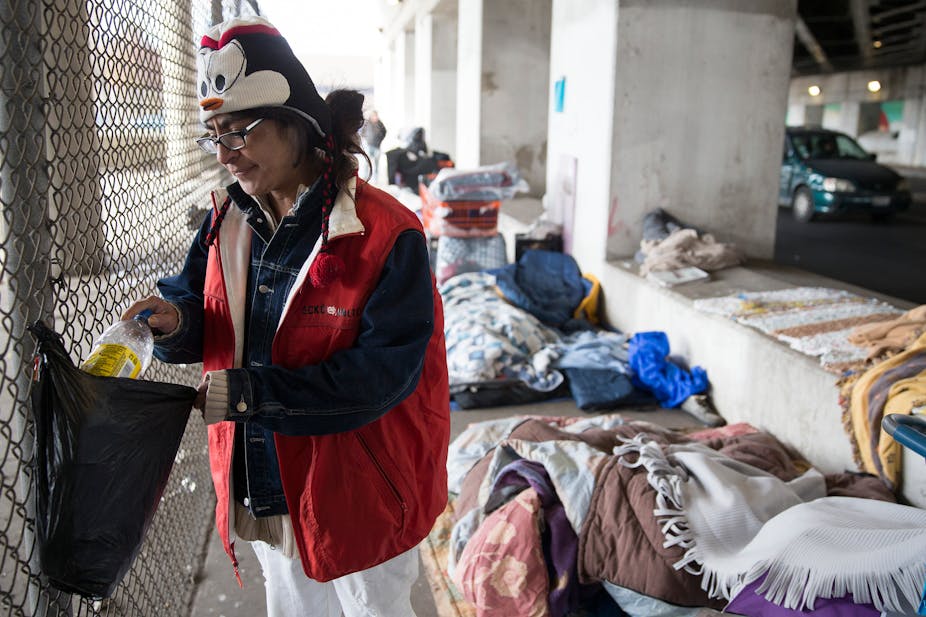This year marks the 51st anniversary since Lyndon Johnson launched his War on Poverty and made poverty reduction the centerpiece of his Great Society domestic agenda.
Whether we won this war, however, is still a subject of much debate.
1960s: significant achievements
There was considerable optimism in the 1960s that we could defeat poverty. Standards of living rose rapidly in that decade, income inequality declined, and civil rights were expanded for previously disenfranchised groups.
From 1964 -— the year the War on Poverty was declared -— to 1969 the poverty rate dropped substantially from 19% to 12% (and reached a low of 11% in 1973).
In 1971, Robert Lampman, who had been a key economic adviser to President Lyndon Johnson on antipoverty initiatives, predicted that poverty would be eradicated by 1980. Unfortunately, this did not come to pass.
1970s - 2000s: down, up and down
During the 1970s and 1980s, economic growth slowed and income inequality grew. African Americans, particularly in many inner cities, continued to fare poorly, and the number of Hispanics living in high poverty neighborhoods also grew. Believing that government programs did little to reduce poverty, Ronald Reagan quipped in 1988, “My friends, some years ago the federal government declared war on poverty —-and poverty won.”
In the 1990s, the economy was stronger and poverty fell for all groups.
But the new millennium has been unkind to a large swath of Americans. Income inequality resumed its upward march and wages stagnated for middle- and low-income workers. Two recessions, including the crippling Great Recession in 2007-2009, threw many out of work and wiped out the wealth of millions through foreclosures and plummeting housing values. In 2013, even years after the official end of the recession, the poverty rate remained high at 14.5%.
It could hardly be said, therefore, that the War on Poverty has been won. However, it has not been entirely lost either.
Some battles not lost
First, the official poverty rate remains lower than at the outset of the war on poverty. Moreover, official poverty figures mask certain improvements in the lives of people near the poverty line. Welfare programs today are less likely to deliver the cash benefits that are counted in official poverty statistics and more likely to include non-cash or near-cash benefits, such as in the form of health and housing subsidies and the Earned Income Tax Credit, that are not. In other words, families are getting more help to meet basic needs than it appears using official statistics.
Second, we’ve waged this war in the face of very stiff economic winds since the early 1970s.
Globalization and de-industrialization eliminated many relatively well-paying jobs for people with modest levels of education. As a result, men’s wages, particularly for men with less than a college degree, declined markedly after the early 1970s and have not recovered since. Median household incomes continued to rise from the 1970s until 2000 mainly because of the large growth in the number of women working, but even this improvement stalled and reversed in the 2000s. The cost of health care and a college education also have risen markedly in recent decades -— far faster than inflation.
All of these trends mean that working families, including middle-class families, now struggle with issues of affordable child care, health care, and education of their children — the last being increasingly important in securing a good-paying job. These problems do not afflict the nation’s top earners, who have seen spectacular gains in their wealth in recent decades.
With the nation politically divided, it is unlikely that any large-scale legislation directed at the nation’s low-income population will be enacted any time soon. However, there are some policy options that could serve to reduce poverty and which are still broadly consistent with bipartisan goals of reducing hardship while not increasing dependency or stifling economic growth.
Focus on children
Generally speaking, policy has been more effective at reducing poverty among the elderly than among children in the United States. For example, according to one estimate, Social Security lifts 15 million elderly Americans out of poverty. We should therefore now consider a number of strategies that assist working parents, reduce poverty, and provide an investment in children.
The United States is one of the very few countries in the world that does not provide paid time off for new parents. Such leave allows parents to stay connected to the labor market while still providing needed care for their infants. Likewise, universal preschool for children ages 3 and 4 would also support parental work and invest in early childhood education. Some of the cognitive inequalities between children of low- and high-income households are already present by the time children reach kindergarten.
Another program that has been implemented by a number of local governments including that of New York City, SaveUSA, offers low-income families an incentive to save at tax time by partially matching the amount of money families put aside. Encouraging individuals to save, even a little, can create a path toward longer-term financial stability and investment. Finally, and most challenging, is improving K-12 schooling so that we reduce wide disparities in the quality of education American children receive.
While we have not won the war on poverty, it is important to recognize that many of our efforts have reduced hardship among our most vulnerable citizens. Providing opportunities for upward mobility to children in unequal times remains critical to our future prosperity.

